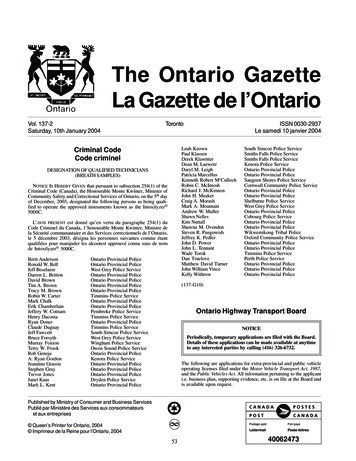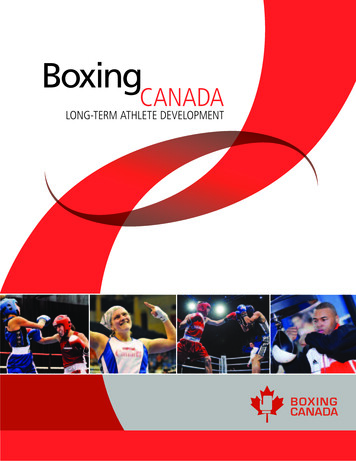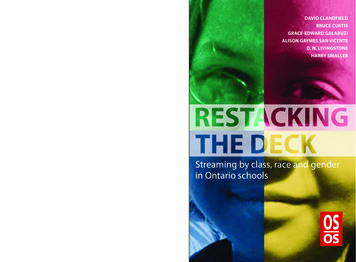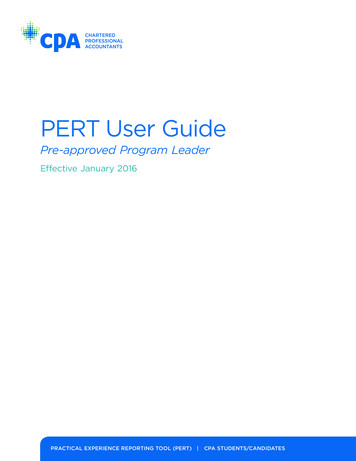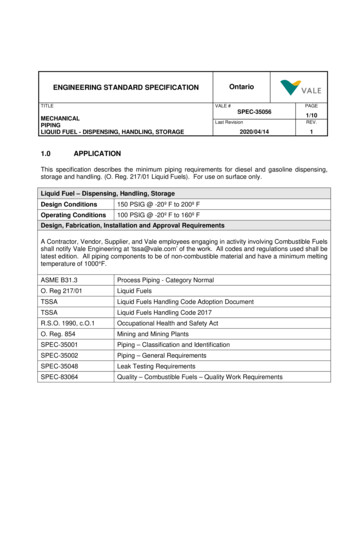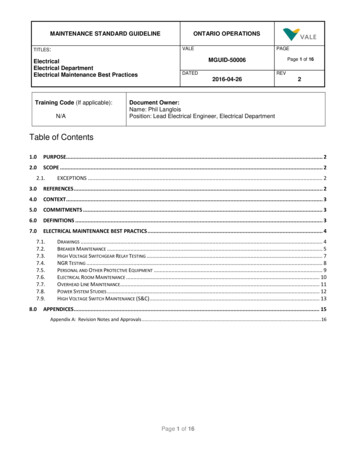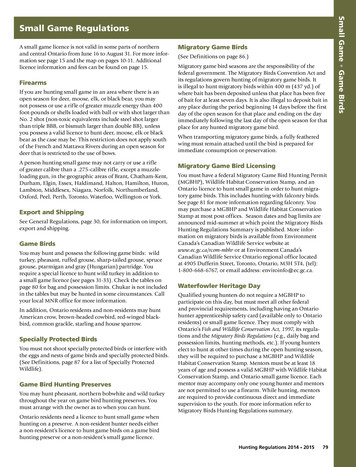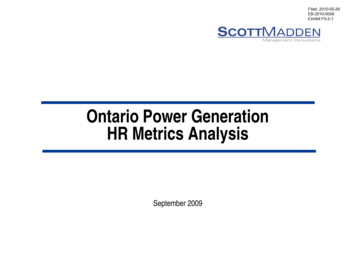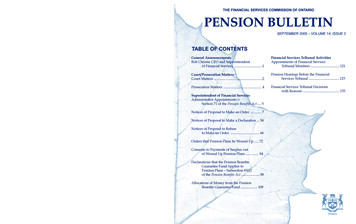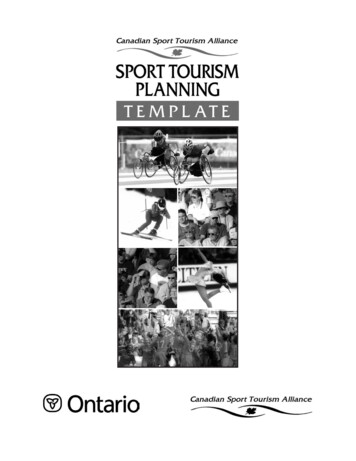
Transcription
SPORT TOURISM PLANNING TEMPLATEWelcome to the Sport Tourism Planning TemplateThe purpose of this planning template is to help communities understand sport tourism and plan tobecome more actively involved in this emerging tourism market segment.The plans that are produced using this template will be specific to each community, but the steps inthe planning process through which the plan is prepared are quite universal.The template is designed to follow four stages:Stage 4 – Building a Strategic ApproachWhere we want to goßStage 3 – Setting Objectives and Building a VisionWhere we are nowßStage 2 – Assessing Community CapacityWhat we need to knowßStage 1 – Expanding Knowledge of Sport TourismHow we will get thereFor each stage, worksheets are provided to assist in capturing ideas and information that will form thebasis of the plan. In most cases, the worksheets should be completed by individuals or small groups,and the results shared with the broader group. The discussion generated by different responses willassist in identifying key issues, and help select the best strategies or solutions in dealing with thoseissues.Planning requires resources and, while the template will allow you to move more rapidly andexpeditiously through the process, you should be prepared to commit some resources, especially time,for the completion of the work around the template. This will include: Time to assemble a group of people who represent the various partners or stakeholders insport tourism in your community. Time for people to review the materials and to work through the individual worksheets. Time for people to come together to share their worksheet information, or for theworksheets to be gathered together and the results summarized. Time to discuss the learning from the compiled worksheets, and to review collectively wherethe group is, where it wants to go, and how to get there. Time to pull together all these ideas and materials into a written document, and to move itthrough all the appropriate channels. The template should also be considered as a kit oftools. The work to be done in your community may require some or all the tools containedin this template. Please feel free to mix and match them as appropriate.In some communities, one organization may be able to lead the overall planning process. In others,it may be decided to retain the services of a facilitator to help the group work through the process.The template will be a useful tool in both situations.Please also provide us with feedback on the effectiveness of the process in your community, so thatthe template can be revised and improved accordingly.The Canadian Sport Tourism Alliance has created a variety of leading edge industry tools thatcomplement this planning template. See Appendix 1 for details and visit the web-site atwww.canadiansporttourism.comCanadian Sport Tourism Alliance
SPORT TOURISM PLANNING TEMPLATETable of ContentsStage 1 – Expanding Knowledge of Sport Tourism . . . . . . . . . . . . . . . . . . . . . . . . . . . . . . . . . . . . . . 4Worksheet: Agency / Organization Assessment . . . . . . . . . . . . . . . . . . . . . . . . . . . . . . . . . 12Stage 2 – Assessing Community Capacity . . . . . . . . . . . . . . . . . . . . . . . . . . . . . . . . . . . . . . . . . . . . . . 13Worksheet: Community Strengths & Weaknesses . . . . . . . . . . . . . . . . . . . . . . . . . . . . . . . 16Worksheet: Sport Event Resume . . . . . . . . . . . . . . . . . . . . . . . . . . . . . . . . . . . . . . . . . . . . . . . 17Worksheet: Sport Strengths . . . . . . . . . . . . . . . . . . . . . . . . . . . . . . . . . . . . . . . . . . . . . . . . . . . . 18Worksheet: Sports with Potential. . . . . . . . . . . . . . . . . . . . . . . . . . . . . . . . . . . . . . . . . . . . . . . 19Worksheet: Facilities Inventory . . . . . . . . . . . . . . . . . . . . . . . . . . . . . . . . . . . . . . . . . . . . . . . . . 20Worksheet: Accomodations Profile . . . . . . . . . . . . . . . . . . . . . . . . . . . . . . . . . . . . . . . . . . . . . 21Stage 3 – Setting Objectives and Building a Vision . . . . . . . . . . . . . . . . . . . . . . . . . . . . . . . . . . . . 22Worksheet: Vision Survey . . . . . . . . . . . . . . . . . . . . . . . . . . . . . . . . . . . . . . . . . . . . . . . . . . . . . . 25Stage 4 – Building a Strategic Approach . . . . . . . . . . . . . . . . . . . . . . . . . . . . . . . . . . . . . . . . . . . . . . . 27Worksheet: Sport Tourism Opportunities . . . . . . . . . . . . . . . . . . . . . . . . . . . . . . . . . . . . . . . 34Worksheet: Sport Event Calendar – Potential . . . . . . . . . . . . . . . . . . . . . . . . . . . . . . . . . . . 36Worksheet: Support Resources . . . . . . . . . . . . . . . . . . . . . . . . . . . . . . . . . . . . . . . . . . . . . . . . . 37Worksheet: Action Planning. . . . . . . . . . . . . . . . . . . . . . . . . . . . . . . . . . . . . . . . . . . . . . . . . . . . 38CSTA Products and Services . . . . . . . . . . . . . . . . . . . . . . . . . . . . . . . . . . . . . . . . . . . . . . . . . . . . . . . . . . . . 39Canadian Sport Tourism Alliance 3
SPORT TOURISM PLANNING TEMPLATEAcknowledgementsWe would like to acknowledge the contributions of the following agencies and individuals in thecreation of this template: Funding for the overall project was provided by the Investment Development Office of theOntario Ministry of Tourism and Recreation. The template was a by-product of the preparation of a Sport Tourism Action Plan forTourism Hamilton, who we thank for overall contract administration and support. The original idea for a template came from the Ontario Stakeholder Session at Sport EventsCongress 2003, and impetus for its development was maintained by the Canadian SportTourism Alliance and its Chief Executive Officer, Rick Traer.Both the Hamilton Sport Tourism Action Planand the template were written by Bob Yates ofYates, Thorn & Associates, 50 Beach Drive,Victoria, BC V8S 2L4 (bob@yatesthorn.com)Bob is a professional planner with an extensivebackground in both sport and tourismindustries. He has worked with both federaland provincial governments providing supportand advice on a range of sport and tourismissues for over 20 years. During the 1990s, hewas a consultant with the Canadian TourismCommission contributing to the developmentof the Canadian Sport Tourism Initiative. Weare grateful to Bob for partnering with CSTA,Tourism Hamilton and the Ontario Ministryof Tourism and Recreation on thedevelopment of this template.Copyright 2004Canadian Sport Tourism Alliance and theOntario Ministry of Tourism and Recreation.All rights reserved.Canadian Sport Tourism Alliance 4
SPORT TOURISM PLANNING TEMPLATEStage 1 – Expanding Knowledge of Sport TourismThis section of the planning template is designed to increase the understanding of sport tourism, andits value to communities.The following information is contained in this section:Information SheetsWorksheetsWhat is Sport Tourism?The Event MarketplaceThe Dimensions of a Sport Tourism EventEconomic Revenues and ExpendituresSocial Costs and BenefitsWho’s InvolvedAgency / Organization AssessmentBy the end of this stage, each member of your planning team will have a better understanding of howhosting sport events help a variety of organizations or agencies achieve their goals and objectives.What is Sport Tourism?Sport is a major industry, and is a reason people travel. Whether it is the world’s high performanceathletes traveling to the Olympics or their sport’s world championships, or a family traveling withtheir son or daughter to a weekend regional event, two conditions apply: They are tourists – when they travel more than 80 km. and/or stay overnight.Sport is the reason they travel - they would not have traveled to that location had it not beenfor that specific event.The scale of the sport tourism marketplace is significant: The Sub-Committee on the Study of Sport in Canada estimated that there are over 200,000sport events that occur annually in Canada1.9.6m Canadians regularly participate in sport, either as athlete, coach, official or volunteer2.The Canadian Tourism Commission estimates that sport travel in Canada is valued at 1.3billion annually.Sport events can have a major economic impact, as follows:Event2002 North 2002 SkateCanadaAmericanIndigenous InternationalGames2003CanadaWinterGames2003 World 2003 WorldCyclingYouthChamps.AthleticsChamps.2004 BrierEconomicActivity 15.5 M 6.3 M 70.3 M 37.4 M 48.3 M 23.1 MGDP 7.4 M 2.6 M 28.6 M 17.2 M 20.2 M 11.0 MJobs205741015600527238Taxes 4.8 M 898 K 10.4 M 6.3 M 8.4 M 3.1 MNote: These results are compiled from reports commisioned by CSTA, using the STEAM model. See CSTA website(www.canadiansporttourism.com) for more information and the full reports.12Sport in Canada - Everybody’s Business, Page 32Sport Canada (1999)Canadian Sport Tourism Alliance 5
SPORT TOURISM PLANNING TEMPLATEThe Dimensions of a Sport Tourism EventThe size and value of sport events varies with a number of factors. These include: Number of participants - Including athletes, coaches and officials. Number of spectators - Some sport events such as major curling bonspiels have fewparticipants but many spectators. Length of event - Many events are just one day in length; others run for a week or more.Some, such as the World Cups of soccer and rugby, extend for 4 to 6 weeks. Frequency of event - Events that occur every year are also, in the long term, verysignificant. The Around the Bay Road Race has been drawing sport tourists to Hamiltonsince 1894. Calibre and status of the event - At the top of the scale are events such as the Olympics,Commonwealth Games or major world championships. They combine most of the aboveelements of large numbers of spectators and participants, frequency and event length. Butin addition, they bring the dimension of television and media coverage, which provides theevent with added visibility, added revenues from the host broadcaster, and added corporaterevenues from event and TV advertising. These are what are referred to in the literature as‘hallmark’ events, and it is the competition for these events which is becoming particularlyintense in the international event marketplace. The 2003 World Road CyclingChampionship, for example, attracted over 270 million viewers worldwide. Event legacies – the potential of the event to leverage investments that will have lastingimpact is referred to as legacy value. Whether it is facilities that are built for the eventwhich will provide long term public service, volunteer training, or funds for scholarships foraspiring athletes, they all provide long term community value.Although mega events tend to capture most of the media attentionand public profile, it should be noted that the critical mass ofactivity in the industry segment continues to occur at theintercommunity level.The economic impact of sport events is clearly significant, and alarge proportion of it accrues to the tourism industry as payment fortravel, meals and accommodations.The key to success in the development of a sport tourism strategy isfostering collaboration between the tourism and sport stakeholdersso that both sectors can benefit from increasing the value of events.Canadian Sport Tourism Alliance 6
SPORT TOURISM PLANNING TEMPLATEThe Event MarketplaceA simple stratification of the market identifies six market segments as ivesingle sport events:ProfessionalSport Events* International* National/Canada* Provincial* RegionalCreatedEventsNon-competitiveEventsThe number of events is startling. One estimate is that there are over 200,000 events annually inCanada3. The question becomes, how does a community choose a set of events that it should host?Competitive Single Sport and Multi-sport EventsThe type of event that can most easily be included in a sport tourism strategy is a competitive, singlesport event, either international (world or North American championship), national championship,provincial championship, or regional championship.Based in part on the proposal for an International Hosting Strategy4, a five level hierarchy of sportsevents can be proposed:Level 1 – Major International Events (Multi or Single Sport)Level 2 – Small International EventsLevel 3 – National and Provincial EventsLevel 4 – Intra-Provincial and Open EventsLevel 5 – Local Events34Sport in Canada: Everybody’s Business (Sub-Committee on the Study of Sport in Canada – the Mills Report), page 28 - 1998Hosting International Sport Events in Canada – A Proposal for a Strategic Framework - Report to the Secretary of State(Physical Activity and Sport) - September 2003Canadian Sport Tourism Alliance 7
SPORT TOURISM PLANNING TEMPLATEInvitational EventsThere are many invitational events hosted by community organizations. They range from slo-pitchtournaments to curling bonspiels. They tend to be local in their orientation, although at slightlyhigher competitive levels in some sports, the “tournament” is the way that athletes are introduced tohigher levels of play.Invitational events can therefore be of enormous scale: some youth soccer tournaments can havethousands of participants.As with local championship events, techniques to maximize the “tourism” component need to bedeveloped.Created EventsCreated events are generally invitational events that are custom designed to serve a specific purpose.They are increasingly used in the United States for a tourism purpose. An example might be acombination of low hotel occupancy and low arena usage at the end of the hockey season leading to ahockey tournament being created.An example is the “Golden Oldies” tournaments that are sponsored by Air New Zealand that focuson masters-level participants. The events are held in New Zealand or in a city to which Air NewZealand flies!There is always potential for creating events to fill specific niches, but the logistics rely on findingvolunteers to organize the events which can be a problem outside of the normal sport organizationalstructures.Non-competitive eventsThere are a wide range of non-competitive events that can fit into a sport tourism strategy: Sport conferences and meetings – sport governing bodies have annual general meetings andmany other meetings to discuss everything from rule changes to drug policies. Some ofthese meetings are open for bid, especially for larger sports and organizations, but many aresimply set by the board. Training courses and clinics – athlete training, team preparation, spring training all are keyparts of the sport industry and involve participants’ spending in other cities on hotels andrelated tourism expenses. These are often organized by the sport governing bodies, but canalso be privately organized by individuals or by colleges and universities.Professional Sport TeamsProfessional sport teams tend to serve a localmarket for spectator entertainment. They dobring visiting teams and spectators to town, andcontribute to the economic health of thecommunity in the process.Canadian Sport Tourism Alliance 8
SPORT TOURISM PLANNING TEMPLATEEconomic Revenues and ExpendituresEvents have both revenues and expenditures:RevenuesFlows of money into the city or regionExpendituresFlows of money out of the city or regionParticipant expenditures – Someparticipants will travel to the city, stay inhotels or other accommodation, eat, drink,buy souvenirs, etc. Depending on theevent demographics, they may spend 75per day or 500 per day.Bidding costs – While hallmark events arehighly sought after and a bidding feerequired, other events are available for theasking.Spectator and other visitor expenditures Whether local people come to the eventfor one day, or whether team supporterstravel across the globe to see their teamplay, they all spend money as a result oftheir event attendance.Direct event revenues - Revenues fromadmission fees, television rights, corporatesponsorships, concession fees, licensinglogos.Non-direct visitor expenditures - Forsome people, the event is the principalreason to travel to a city, but for others theevent serves as something to do while theyare there.Local multipliers - Money spent for theevent circulates around the local economy.Return visitor expenditures - People enjoythemselves at events, often seeing a city orregion for the first time; some of them mayreturn in future years for further travel andtourism experiences.Capital construction costs - Local venuesfor the event may need to be constructedor upgraded, as well as other civic amenityupgrading such as expanded roadimprovements. While these may be costsfor one event, they may have lastingbenefits either for other events or for thegeneral city infrastructure.Event hosting direct costs - Staff must bepaid, venues operated, officials reimbursed,hospitality provided, tickets printed, etc.Event hosting indirect costs - Major eventsrequire extra police and security costs, forinstance, which fall on the community, notthe event organizers (although sometimesbilling by the police authority turns theseinto direct costs).Post-event costs - After the event, facilitiesmay need to be returned to their pre-eventcondition, and the event organization maycontinue for several months to close thebooks, store records, complete finalevaluation reports, etc.Canadian Sport Tourism Alliance 9
SPORT TOURISM PLANNING TEMPLATESocial Costs and BenefitsEvents also bring social costs and benefits:BenefitsSocial benefits of eventsCostsSocial Costs of event hostingRegional identity enhancement - Events,especially hallmark events, help to putcities on the map, and to establish theiridentity in global terms.Congestion – events often bring manyvisitors, which also mean congestion onthe streets, hotels and restaurants forresidents and other visitors.Youth development - Sport events showyoung people what the potential is, andindirectly challenges them to aspire to thatpeak of performance.Dislocation – events often reduce accessby community users to recreation facilitiesand, with major events in particular, lowincome downtown populations getdisplaced by those willing to pay more fortheir rental accommodation.Enhancement of cultural, ethnic orminority groups - Many events arefocused on or within cultural groups, andserve as a mechanism for culturalexpression.Volunteer development - Events are oftenrun by volunteers and event-specificvolunteer training can have longer termcommunity benefits.Competition for funds – non-sportgroups often note that major events drawall available funding, causing a shortage offunding for other, often social, causes.Competition for volunteers – the sametheory applies to volunteers when majorevents are involvedCultural development - Events often havecultural components which encourage andallow local cultural expression anddevelopment.Catalytic development - In many ways,events and all their related activity changea city or serve as catalysts for change. Thiscan be a cost or a benefit, depending onthe change.Canadian Sport Tourism Alliance 10
SPORT TOURISM PLANNING TEMPLATEWho’s InvolvedSport tourism exists at the margin of two very different industries. It comes together as a partnershipof those two industries when the synergies of the stakeholders merge. The various stakeholders andtheir mandates and interests in sport tourism are as follows:Use theWorksheet‘AgencyAssessment’to gather dataon this topic.Destination MarketingOrganizations for TourismThese offer an arms length and business orientedapproach to service delivery, and often see sport eventsas one of their service priorities.City CouncilsCouncils have responsibility for economic developmentand tourism, and sport and recreation. They areinterested in the economic, social and community vitalityof the city to which sport tourism can contribute.City Parks, Recreation andCulture DepartmentsThis department’s focus is often on recreat
Both the Hamilton Sport Tourism Action Plan and the template were written by Bob Yates of Yates, Thorn & Associates, 50 Beach Drive, Victoria, BC V8S 2L4 (bob@yatesthorn.com) Bob is a professional planner with an
